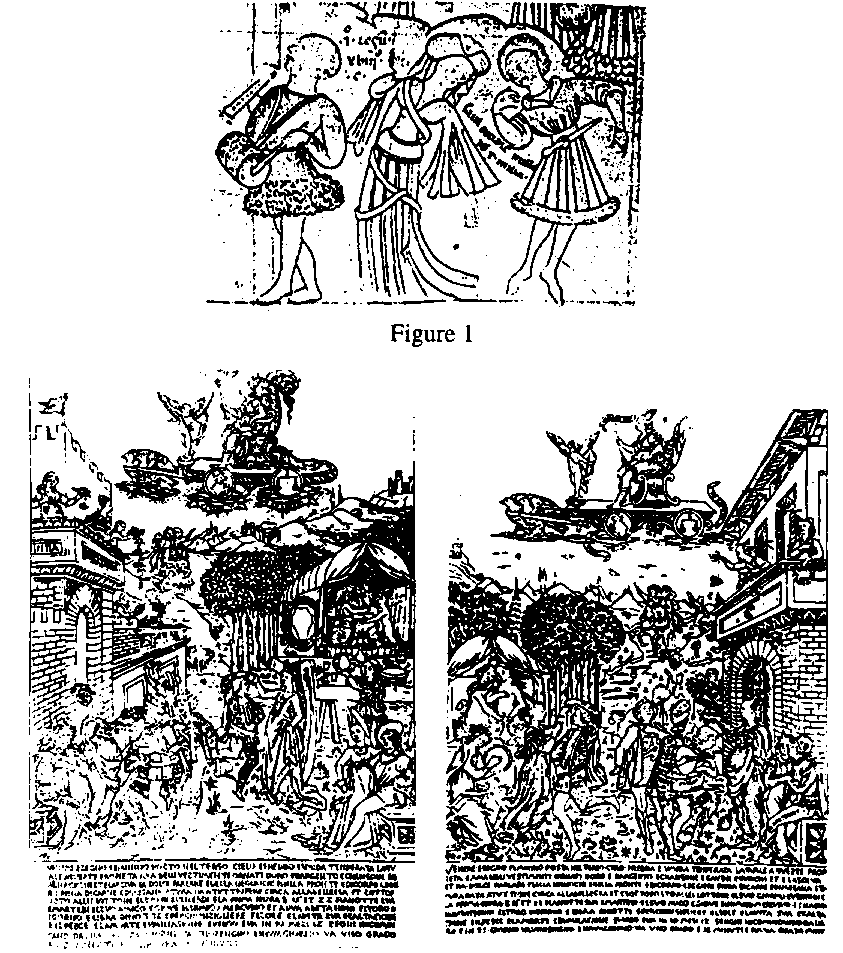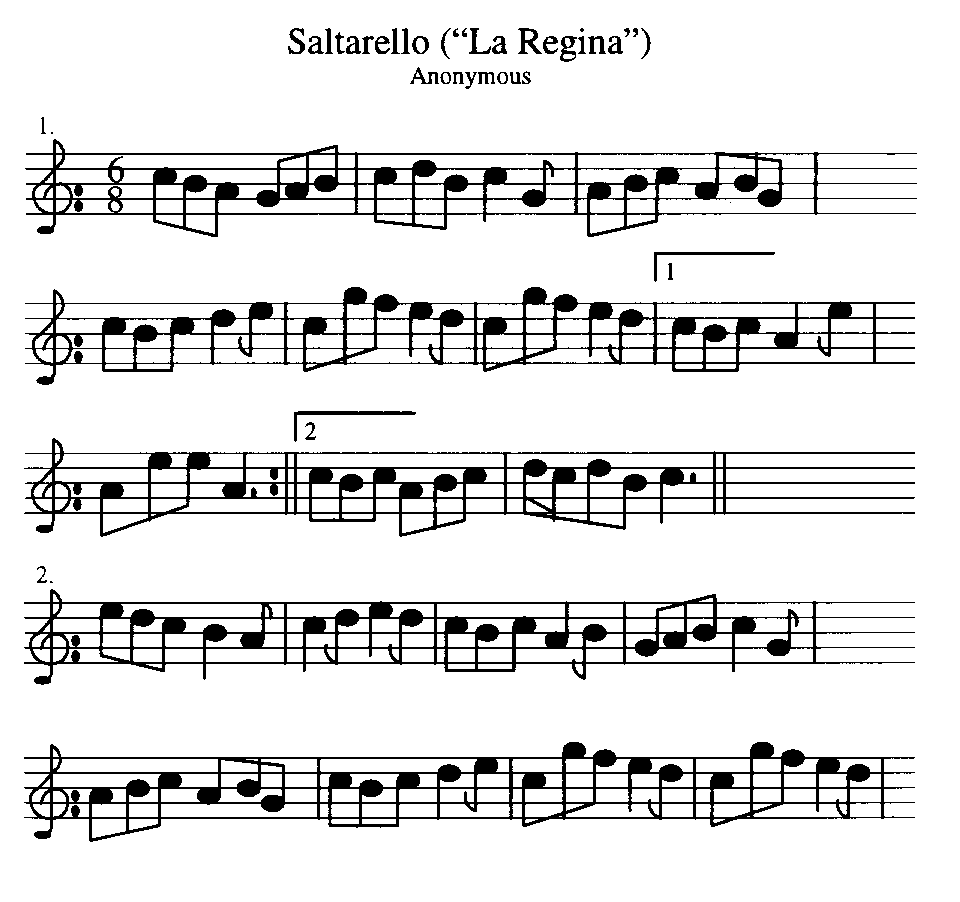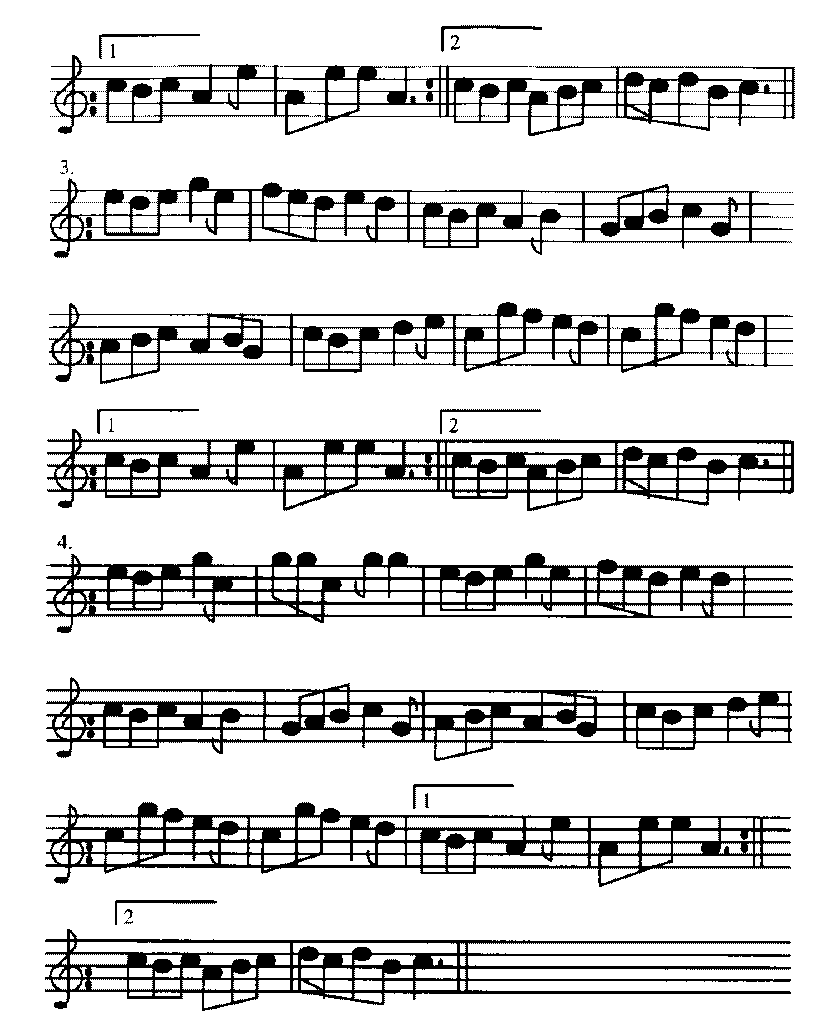
[ This article appeared in volume 1 of the Letter of Dance. ]
La Regina is a reconstructed dance choreographed to the famous treble-time Saltarello in C, found in a late 14th century manuscript from northern Italy. [1]
The dance is done in couples facing the musicians. It is lively and frank in spirit, well suited to nobles in a vernal mood, and it has proved successful here in the Northeast.
However, some lively dance tunes were preserved, and it is possible to use them to choreograph dances which are both plausible within our knowledge of medieval dance, and easily accessible to the average Scadian. This is the idea which underlies La Regina, a dance which expresses the liveliness of its music in a form consonant with documentation from the period. I have attempted to set forth the means by which this was done, partly so that others may critique the work, but mostly in the hope that others will build upon it: there are a lot of very good dance tunes from the Middle Ages crying out for choreography.
The music itself dictated the general character of this dance. It is described in the manuscript as a `saltarello', and the springiness of the melody confirms the idea that it should be danced in lively saltarello steps. The use of inside foot is somewhat anomalous for period dance: it was required to get the `apart-together' figure in the chorus (which is documented). It would be possible to do the dance on the left foot, in which case both partners would move sideways together in the chorus.
The form of the dance is also based on the form of the music. Like many medieval dance tunes, it has `verses' and a `chorus': each verse is played twice, once followed by the `open' version of the chorus, once followed by the `closed' version. The chorus may be divided up as follows: 4,2,2,4.[2]
The verses are of various lengths:
1) 2,2Obviously, the division of the music into singles and doubles is a matter of opinion, and this division is based essentially on the gut-feeling of a dancer and musician.[3]
2) 2,2,2,2
3) 2,2,2,2
4) 2,2,2,2,2,2
The choice of formations is based largely on 14th-15th century visual evidence and dances. The apart-together section of the chorus was inspired by an early 15th century Catalan picture (figure 1). The turning figure of the second verse is quire well documented in 15th century Italian art (figure 2). The dance-around of the third verse is reminiscent of a similar figure in `Geloxia'. A two-hand turning figure, comparable to the fourth verse, is represented in 15th century art (figure 3). The doubles forward and back, as well as the single steps of the opening verse, can be found in the 16th century almain, a dance genetically related to the saltarello.

[Editor's Note: my apologies for the mediocre quality of the figures; by the time they get to you, they are fourth-generation copies, with the expected decline in clarity.]
The most suitable recorded version known to me is on the album Chansons der Troubadours by the Studio der Frühen Musik.
[Figure 3 was completely illegible, so I didn't scan it. -- greg ]
Ingrid Brainard, The Art of Courtly Dancing in the Early Renaissance (West Newton, MA, 1981) The standard work on the subject.
Timothy McGee, Medieval Instrumental Dances (Bloomington and Indianapolis, 1981) Contains the most recent edition of the Saltarello.
Patri J. Pugliese and Joseph Cassazza, Practise for Dauncinge (Cambridge, MA, 1980) A good source for the 16th century almain.
Enclosed are three versions of the Saltarello from BL Add. ms. 29987, ff 62v-63r, which I have labelled "short form", "common form", and "long form". The three differ in whether certain measures are repeated. There is a notation in the ms which might or might not mean "repeat everything between these marks"; the short form ignores this notation, while the long form assumes it means "repeat" everywhere it occurs. The "common form", a compromise between the two, is approximately the way the piece is played on most recordings; I have no idea how this compromise was reached, since the piece does not appear in any other primary source.
[The printed version is condensed from the "common form", which appears to match the choreography to La Regina. The other two versions are available from the Letter for a SASE. -- Justin]


[2] `2' represents the time of a single step, 4 the time of a double step.
[3] Note that the manuscript form of the chorus has only 4,2,4. Most written and recorded versions of the music choose to double the middle part; however, it would be possible to dance it as written in the manuscript, in which case the dance should start on the left foot, and the repeats will be on the right.